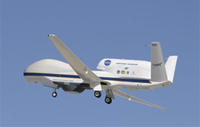-
Testing new pavement materials
Scientists are trying to determine the durability of recycled materials for use in road construction; a Texas university is building a new accelerated pavement testing center, with the overall road pad at the accelerated pavement testing center could be a little bigger than a half-acre in size
-
-
MIT expert: “toxic” political discussions limit climate response
In a talk at the Sandia National Lab, an MIT expert says the inability of natural and social scientists to convince political leaders that “we’re spinning a roulette wheel over climate change” puts humanity at “extreme risk,” and that the difficulties in using science to push for mitigation strategies are more political than scientific
-
-
As shoe-scanning devices fail, passengers continue to remove their shoes

In the last five years the U.S. government has tested several scanning devices for detecting explosives and other weapons concealed in the shoes of airline passengers; after spending millions of dollars on these devices, TSA has concluded that the detection systems are ineffective; the result: removing shoes at security check points is going to be a part of air travel for the foreseeable future
-
-
Engineers develop electricity-free home cooling system
Researchers are developing a solar cooling and heating system for the home which will run independently of the electricity grid and generate domestic hot water as a by-product
-
-
Trade-offs between water for food and for curbing climate change
Earth’s growing human population needs fresh water for drinking and food production. Fresh water, however, is also needed for the growth of biomass, which acts as a sink of carbon dioxide and thus could help mitigate climate change. Does the Earth have enough freshwater resources to meet these competing demands?
-
-
As Hurricane Isaac beats on New Orleans, new infrastructure is holding up

This week, as Hurricane Isaac was threatening to replicate the physical damage that Katrina inflicted, it has become apparent that $14 billion worth of changes and improvements in infrastructure, planning, and emergency response procedures have given the city of New Orleans and the Gulf states the ability to withstand the worst of the storm
-
-
Isaac leaves flooding, power outages in its path

Hurricane Isaac lost its Category 1 hurricane status midday Wednesday and was downgraded to a tropical storm, but the severe rains and winds which it brought with it have not let up much; the number of power outages continues to increase as the number of homes and businesses without electricity is now up to 834,000 between Louisiana, Mississippi, Alabama, Florida, Texas, and Arkansas, with over one-third of the outages in Louisiana alone
-
-
Drones being used to track hurricanes

Federal hurricane trackers will start experimenting with unmanned boats and aircrafts to learn more about how to anticipate and track the movements of hurricanes; NASAand the National Oceanic and Atmospheric Administration(NOAA) are teaming up and using a pair of military-surplus Global Hawk spy drones, which are known more for spying on battlefields than chasing storms
-
-
Industry fights Pentagon efforts to restrict exporting of infrared products
The global market for infrared technology products will be worth about $2.6 billion dollars by 2017; the technology can be used for commercial products such as automotive, surveillance, and security industries – and is heavily used by the military; three major U.S. infrared equipment makers fight the Pentagon’s efforts to restrict exports of devices based on the technology for fear these devices may enhance the military capabilities of adversaries of the United States
-
-
NSF awards Norwich University a grant for computer security scholarships
Norwich University in Vermont was awarded a $975,000 grant from the National Science Foundation’s (NSF) Scholarship for Service program; the funds will be used to support Information Assurance students; the students will fulfill the “service” obligation through employment by a government agency in their area of information assurance expertise for two years
-
-
Underground organisms play a more complex role carbon capturing than previously thought
In a surprising finding, researchers have shown that certain underground organisms thought to promote chemical interactions that make the soil a carbon sink actually play a more complex, dual role when atmospheric carbon levels rise
-
-
Evaluating fresh water sustainability in the southern U.S.
Researchers have embarked on 4-year federal research effort to evaluate freshwater sustainability across the southern United States and develop policy recommendations on what can be done to make the best use of water supplies in the face of population growth and the effects of climate change over the next ten to thirty years
-
-
Hurricane Isaac downgraded from Category 1 hurricane to tropical storm

Hurricane Isaac was downgraded from a category 1 hurricane to a tropical storm. The storms winds have dropped below 70 mph, but the storm is moving very slowly throughout the gulf area at about 6 mph; at this point officials estimate that Isaac is expected to cause $1.5 billion in insured losses
-
-
New Jersey infrastructure badly needs shoring up, and soon
According to experts, changes to the way New Jersey maintains its infrastructure must be made soon, or the state could be vulnerable to catastrophic failures in its water and power systems as well as collapsing roads; the North Jersey Transportation Planning Authority says more than $56.9 billion will be needed just to maintain state roads, rails, and public transportation systems through 2035; when you add in improvements to account for environmental changes and the expanding population in the state, the bill skyrockets to more than $123 billion
-
-
New filter will help clean oil spills
Oil and water disdain each other, but once forced to comingle they are nearly impossible to separate; a new filter separates oil and water using only gravity; the filter could help clean oil spills, or clean water at treatment plants
-
More headlines
The long view
New Technology is Keeping the Skies Safe
DHS S&T Baggage, Cargo, and People Screening (BCP) Program develops state-of-the-art screening solutions to help secure airspace, communities, and borders
Factories First: Winning the Drone War Before It Starts
Wars are won by factories before they are won on the battlefield,Martin C. Feldmann writes, noting that the United States lacks the manufacturing depth for the coming drone age. Rectifying this situation “will take far more than procurement tweaks,” Feldmann writes. “It demands a national-level, wartime-scale industrial mobilization.”
How Artificial General Intelligence Could Affect the Rise and Fall of Nations
Visions for potential AGI futures: A new report from RAND aims to stimulate thinking among policymakers about possible impacts of the development of artificial general intelligence (AGI) on geopolitics and the world order.
Smaller Nuclear Reactors Spark Renewed Interest in a Once-Shunned Energy Source
In the past two years, half the states have taken action to promote nuclear power, from creating nuclear task forces to integrating nuclear into long-term energy plans.
Keeping the Lights on with Nuclear Waste: Radiochemistry Transforms Nuclear Waste into Strategic Materials
How UNLV radiochemistry is pioneering the future of energy in the Southwest by salvaging strategic materials from nuclear dumps –and making it safe.
Model Predicts Long-Term Effects of Nuclear Waste on Underground Disposal Systems
The simulations matched results from an underground lab experiment in Switzerland, suggesting modeling could be used to validate the safety of nuclear disposal sites.
